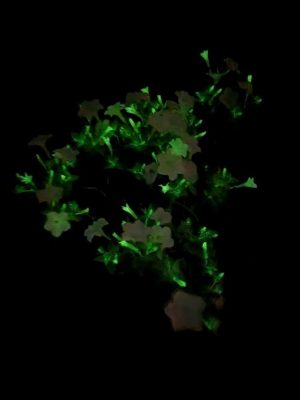By Dr. Matthew Lisy, UConn Adjunct Faculty

The world of genetics has really had a tremendous impact on our lives. There is a lot of talk about GMOs, or genetically modified organisms, in the news. Labels even alert us to the presence of these crops in our foods. I wanted to share a new plant called the Firefly Petunia. It was not fireflies, but mushrooms that gave this plant its ability to glow. This is known as bioluminescence in the world of biology.
Through feats of genetic engineering, a gene is taken from one organism and placed into another. This is where people become worried. Humans, however, have been doing this for hundreds of years. The best looking or most productive organisms were bred together for the next generation. This is called selective breeding, and it essentially concentrates beneficial versions of genes in the offspring.
Now what is determined to be the most beautiful is truly in the eye of the beholder. Some people, for example, selected for white flowers in a normally purple flowered species, Echinacea purpurea. Some have even taken things a step farther and crossed different species of plants to obtain new colors of flowers. In nature, separate species have evolved isolation mechanisms to maintain their identity. When our plant breeders force a cross of the species boundary, much of the time it was done with closely related species of plants within the same genus. A great example of this is the crossing of Echinacea purpurea, the purple cone flower, with Echinacea paradoxa, the yellow cone flower. This was done to obtain hybrid offspring that have red or orange flowers. These were back crossed with the parent varieties, so they have the same growth habit and form, but with new colored flowers.

This hybridizing never really ruffled many feathers though, as the plants were very closely related anyway. More modern GMOs, like our Firefly Petunias, are obtained not through “natural” pollination processes, but through genetic manipulation. Scientists literally take one or more genes from one species and place them in another. These species are not closely related, so it may become an ethical conundrum. Here, one may ask if we should take a gene from a mushroom and place it into a plant. A similar circumstance was seen over twenty years ago in the aquarium industry, where genes from corals and jellyfish were placed into tropical fish to make them fluorescent Glofish.
On the question of ethics, I cannot tell you what to think, or what is right or wrong. We each will need to answer that question for ourselves. It does remind me of a quote from Jurassic Park, where Dr. Ian Malcolm states “…your scientists were so preoccupied with whether or not they could that they didn’t stop to think if they should.” The real question is where do we go from here. For the fish, it was species after species of Glofish, and for me, the novelty started wearing off. After all, how many species will be made fluorescent before it just gets boring? Now for our plants, will we have roads lined with glowing trees to eliminate the need for streetlights? Will we have glowing houseplants that function like night lights? Ultimately, it will be up to you, the consumer.
For me, this is just cool science. We ship and plant petunias all over the world. Are these glowing petunias going to cause any harm? Probably not, as none of the other ones have. When I go outside at night to take the dog out and see the bioluminescent petunias, it puts a smile on my face. It reminds me of the fact that we, as humans, are capable of many things. I can’t help but ponder if this will inspire a sense of awe and wonderment in our children. Maybe some may even study genetics because of these petunias. What if one of them ends up finding a cure for a debilitating human disease, all because of a glowing plant? And while some may say that this daydream of mine is just science fiction, need I remind you that so were glowing plants a few years ago?
For your gardening questions, feel free to contact us, toll-free, at the UConn Home & Garden Education Center at (877) 486-6271, visit our website at www.ladybug.uconn.edu or contact your local Cooperative Extension center.